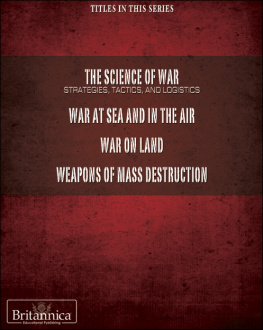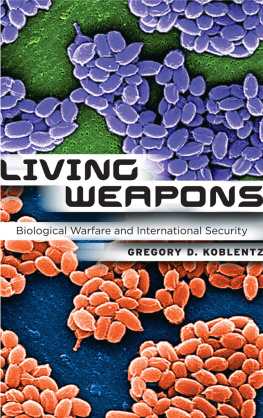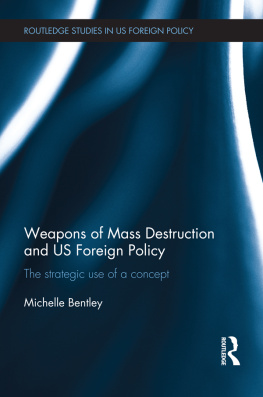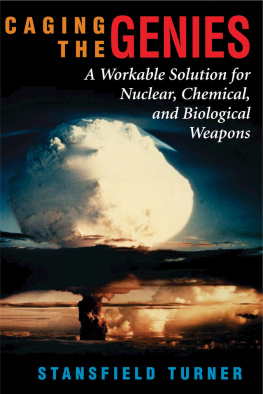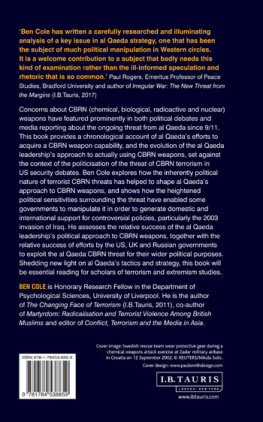First Published in India in 2020
Published by
Vij Books India Pvt Ltd
(Publishers, Distributors & Importers)
2/19, Ansari Road
Delhi 110 002
Phones: 91-11-43596460, 91-11-47340674 Mob: 98110 94883
e-mail:
Copyright 2020, Wg Cdr UC Jha
ISBN: 978-81-94697-48-0 (HB)
ISBN: 978-81-94697-47-3 (PB)
ISBN: 978-81-94697-46-6 (ebook)
All rights reserved.
No part of this book may be reproduced, stored in a retrieval system, transmitted or utilized in any form or by any means, electronic, mechanical, photocopying, recording or otherwise, without the prior permission of the copyright owner. Application for such permission should be addressed to the publisher.
Biological warfare, from a military perspective, is the intentional use of harmful biological agents to affect an adversarys armed forces, population, crops, or livestock. Biological agents are many times more deadly than chemical warfare agents in terms of their scope and span of impact. For instance, ten grams of anthrax spores could kill as many people as a ton of the nerve agent sarin. It is, therefore, highly likely that biological agents will become the preferred choice of weapon for terrorists in future. The pertinent question isAre there norms to curb and control the use of biological agents in warfare?
The 1972 Biological and Toxin Weapons Convention (BTWC), which established norms against the weaponization of pathogens, provided hope that States would commit themselves to ensuring a world free of biological weapons. However, the BTWC had certain congenital defects which provided loopholes for misuse and diversion of pathogens. It was expected that in due course the world community would reach a consensus in overcoming these defects by establishing a verification regime under the Convention. However, the States are yet to achieve this. Fortunately, after the 2001 anthrax attack in the United States, there has not been recorded or established incident of the use of biological weapons around the world.
Currently, SARS-CoV-2 virus responsible for the COVID-19 pandemic is now reshaping the world and has stirred a lot of discussion. In spite of the advanced healthcare facilities in the developed countries, the death toll has reached a new milestone. The pandemic is the worst global health emergency being faced by the world as per World Health Organization (WHO). In a matter of nine months or so, the world has been transformed. As of 30 September 2020, there were about 33.44 million cases of COVID-19, including more than one million deaths, in 216 countries and territories, and on every continent other than Antarctica. These figures are likely to be great underestimations of the true numbers of infections and deaths. A number of countries have had to deploy their armed forces to supplement medical resources. The pandemic has caused widespread loss of jobs the world over and has seriously impacted every sphere of life. Governments, economies, markets and individuals are facing a global crisis situation. The International Monetary Fund predicts that over the next two years, cumulative output losses from the pandemic could reach US $9 trillion.
There have been allegations that the virus responsible for the pandemic was released accidently from a laboratory in China. Whether this is true or otherwise, keeping in view the extent of its impact, the possibility of it or similar potent biological agent, becoming a weapon of the future cannot be ruled out. As the world community is fighting hard to bring the situation under control, rogue actors may take advantage of the pandemic and may use biological weapons to similar effect. Such terrorist attacks would be widespread and indiscriminate, affecting every State.
New technologies for gene-editing, such as CRISPR and 3-D laboratory printing equipment have added a new dimension to it by making it possible to produce militarily significant quantities of pathogens and toxins in a make-shift laboratory or garage. In contrast to nuclear or chemical weapons, no specialized starting materials are required for the production of biological and toxin agents except for a small seed stock of a disease-producing organism, which is easy to procure due to possibility of dual-use.




